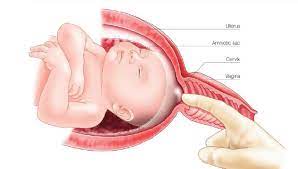Rupture of Membranes
Rupture of membranes, also known as “waters breaking”, is a common occurrence in pregnancy when the amniotic sac containing the baby ruptures. In addition to routine prenatal care, ultrasound scans may help identify a potential rupture of the membrane during pregnancy. Please keep reading for details on the following topics:
Ways to determine if the membranes have ruptured
What to do if the water breaks
Types of rupture of membranes
Preterm prom (PPROM)
Treatment for PPROM
When to seek urgent medical care

WAYS TO DETERMINE IF THE MEMBRANES HAVE RUPTURED
The woman will feel a rush of cloudy-white to an amber-straw color water from the vagina or may dampness to the vagina
The pH level of the fluid is tested by using nitrazine paper
The fluid will be placed under a microscope to look for a fern-like appearance when it dries
A speculum examination can be performed to determine the origin of the fluid
Through a vaginal examination, the membranes cannot be palpated if they’re ruptured
An ultrasound scan to determine the fluid level in the uterus

IF THE WATER BREAKS
Write down the time the water broke, the color and appearance of the fluid, the estimated amount that came out
Seek medical care immediately
Be sure to have a hospital bag packed
Let the midwife or doctor know if the leaking fluid:
Is dark or greenish. Meconium (from a baby’s first bowel movement) may be in the fluid
Smells bad – this could be a sign of infection in the uterus
Is bloody. Small streaks of blood are normal. But if the entire fluid is stained with blood, it could be a sign of a problem with the placenta
TYPES OF RUPTURE OF MEMBRANES
Spontaneous rupture of the membranes occurs when the waters break by themselves
Artificial rupture of the membrane occurs when membranes are ruptured by the doctor or midwife to start or speed up labor
An artificial rupture of membranes is done during a contraction. The doctor or midwife will insert a sterile plastic hook into the vagina and pulled gently on the amniotic sac until the sac breaks

Preterm PROM (PPROM)
PPROM (preterm premature rupture of membranes) is a particularly serious and often dangerous complication, occurring before 37 weeks’ gestation. This condition can be life-threatening for both mother and baby as it increases the risk of infection and preterm labor. To complicate matters further, PPROM can occur without any warning signs or symptoms, leading to an unexpected delivery. The timely identification and management of PPROM is essential for ensuring better maternal and fetal outcomes. As early diagnosis is key to proper care, all pregnant women should be aware of the signs and risks associated with preterm premature rupture of membranes.
The water breaks before the 37th week of pregnancy
The woman will usually be advised to stay in hospital
The woman will be closely monitored for signs of infection
Blood tests will be done to check for infection
Baby’s heart rate will also be monitored regularly
Treatment for PPROM
It is impossible to repair the hole in the membranes
The woman will be placed on bedrest to reduce chances of delivery
Antibiotic medication will be administered to reduce the risk of infection to the uterus and affecting both mother and baby
- If the woman is well with no signs of infection and baby is growing well in the uterus (womb), then it may be better to allow the pregnancy to continue until 37 weeks. The woman will be monitored very closely for any signs of infection
- If the woman and baby show any signs of infection or develop other complications, she may need to give birth to your baby straight away
A sequence of steroid injections will be administered to help with baby’s lung development and to reduce the chance of complications from being born prematurely
Magnesium sulfate, may be offered to reduce the risk of developing cerebral palsy
WHEN TO SEEK URGENT MEDICAL CARE
It is important to know when to seek urgent medical care, as delaying appropriate treatment can lead to further health complications. If you experience any of the following symptoms, you should seek medical help immediately. If you have any doubts about whether you should seek medical care, it is always better to err on the side of caution and consult with your doctor.
• The leaking fluid becomes greenish or smelly
• Contractions or cramping pain
• Abdominal pain or back pain
• The baby is not moving as normal
Disclaimer: The information provided in this content is for general informational purposes only. It is not intended as medical or healthcare advice, diagnosis, or treatment. Always seek the advice of a qualified healthcare professional with any questions you may have regarding a medical condition or healthcare decisions.

